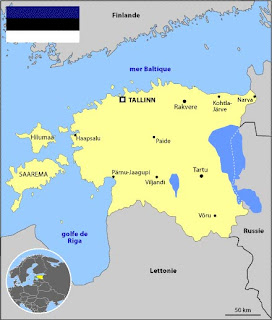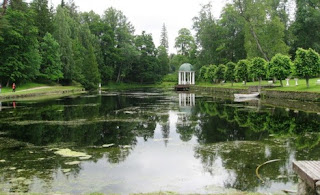 |
| Photo credit: Travel.nationalgeographic.com |
 |
| photo credit: travelsighnposts.com |
 |
| photo credit: travelsighnposts.com |
 |
| photo credit: travelsighnposts.com |
It’s Tuesday and that means it’s time to take an imaginary trip to another country. Today’s destination is Estonia. Estonia is the smallest of the Baltic countries. It’s a great place to visit with its lovely seaside towns, quaint country villages and verdant forests and marshlands. Yet Estonia is also known for magnificent castles, pristine islands and a cosmopolitan capital amid medieval splendor.
 |
| photo credit: state.gov |
 |
| photo credit: ourworldtravels.com |
Tallinn, Estonia's capital is filled with cobbled streets and rejuvenated 14th-century houses. Dozens of cafés and restaurants are situated all around the city. There are many historic churches, scenic ruins, galleries and boutiques to explore during the day. At night, the city is known for its lounges and nightclubs. Lahemaa National Park in Northeastern Estonia has lush forests and beautiful coastal trails. If you love to ski, travel to Tartu, the hilltop town of Otepää located in southern Estonia. Western Estonia is filled with beaches and spa retreats. Further west lies Estonia's biggest island, Saaremaa and the towns of Angla, Karja, Triigi & Tuhkana; here you can find huge Windmills, 19th-century lighthouses, beaches and medieval ruins.
Most of the people who visit Estonia travel through Tallinn, the city’s capital; Tallinn is the most international city of Estonia.
 |
| Photo credit: ec.europa (open air marketplace in Tallinn) |
There are half a million citizens in Tallinn. The traffic is light and everything is relatively close by, making travel easy. Medieval Tallinn Old Town, one of the best preserved hanseatic town centre’s in the world, is just a short walk away from the city business centre with its skyscrapers, modern hotels, luxurious restaurants and shopping malls.
Tallinn’s medieval Old Town is known around the world for its authentic hanseatic architecture. Old Town has houses dating back as far as to 11th century, cobblestone streets, local galleries and museums, tons of cafés and restaurants and local open air markets. Just a 5 minute walk from the medieval Old Town is the business centre of Tallinn: the skyscrapers’ are built of glass and steel, they have tons of high tech hotels and convention centers, hundreds of restaurants and bars, banks and shopping.
Tallinn’s population is just shy of 500,000 people. Estonian and Russian are the most common languages; Tallinn is located in the northern coast of Estonia, on the banks of the Gulf of Finland. It is very close to Helsinki, the capital of Finland.
There are hundreds of attractions to keep you busy while visiting Estonia. If I ever get the chance to visit Estonia I would like to see the Palmse Manor.
Palmse was the first of the manors in Lahemaa National Parkthat has been restored to its former splendour. This makes it the most famous. Restorations started already in the 1970s, in Soviet times. The ensemble provides insight in the life of a Baltic noble family in the 19th century. The house, built in 1782-1785, is like a complete little palace with everything a late baroque palace requires: the gate and cour d'honneur in front, the residential quarters with separate apartments for husband and wife, a festival hall, the park behind with a landscape garden, a lake and several small park buildings. At the same time it is a farm and enterprise with the necessary economy buildings. Manor, orchard, greenhouse, garage and grounds are open to the public. The side buildings have been turned into a hotel and tavern. The interior of the manor is a museum. The rooms show how a noble family in the Baltics used to live in the 19th and early 20th century. All rooms are fully furnitured. However, note that except one chair none of the furniture has actually belonged to the owners of Palmse, family von Pahlen. They had to leave the manor in 1923. Afterwards it was used by the Estonian Defence League, in Soviet times it became a children's summer camp. In other words, all original furniture was lost. Only the ovens and tiling stayed in their place. The present furniture is original from the relevant times but was bought in antiques trade and has never belonged to Palmse.
 |
| photo credit: yahoo images |
 |
 |
| photo credit: yahoo images |
|
 |
 |
| photo credit: yahoo images |
|
 |
 |
| photo credit: yahoo images |
|
 |
 |
| photo credit: yahoo images |
|
The park of Palmse manor is a miniature version of huge palace parks. The part closest to the manor, terraced in two steps, is a baroque garden. Further downhill the lawn leads to an artificial little lake with a couple of little buildings on its shore. The forest beyond the lake has been turned into a landscape garden in English style.
The former garage assembles all kinds of vehicles that may ever have been used in Palmse: old cars and trucks, bicycles, motorbikes, tractors and other agricultural machines. The car museum is located in the building on the right side of the front yard.
The garden area behind the greenhouse is planted with apple, pear and other fruit trees. Some old greenhouses are located along the back wall. The fruit trees are not just any random fruit trees: This orchard is a genetic database and storage. Old, half-forgotten varieties of fruit have been planted here to preserve them.
The 1870s greenhouse is located behind a little canal that brings water to the lake. It served for both pleasure and utility. The central part has palm trees and other tropical plants, a little fountain and sculptures, chairs and tables to relax and dream of the South. The side wings, however, were and are used to plant grapes, lettuce, and delicate fruit.
Sources:















Thanks for your great information, the contents are quiet interesting.I will be waiting for your next post.
ReplyDeleteCar Centre Warrington